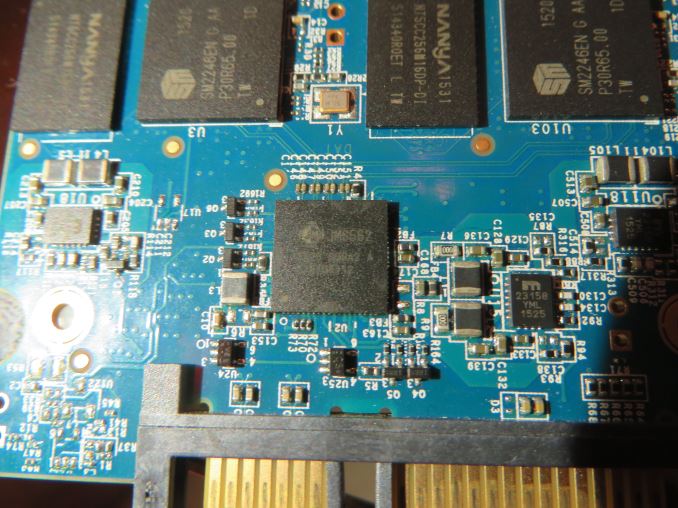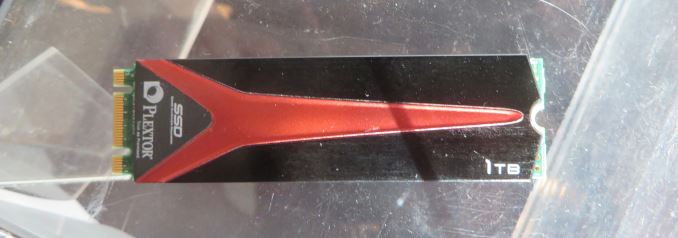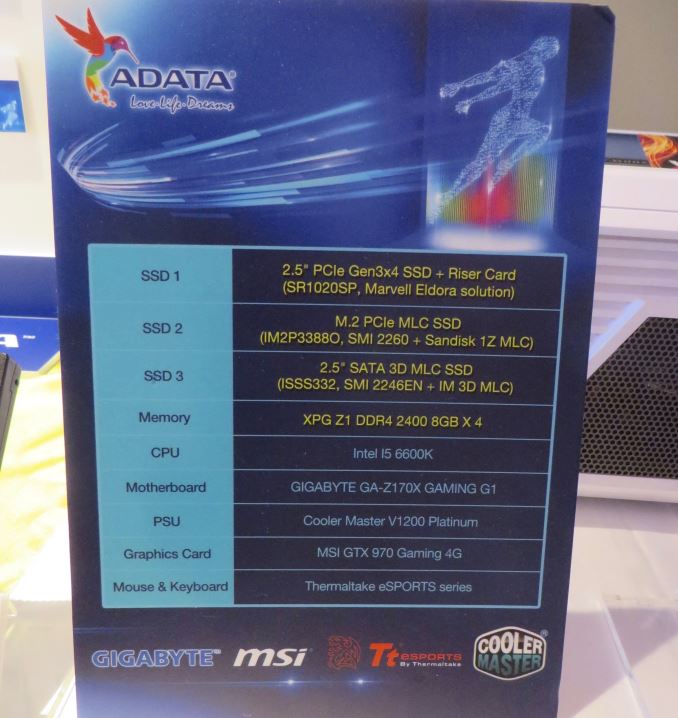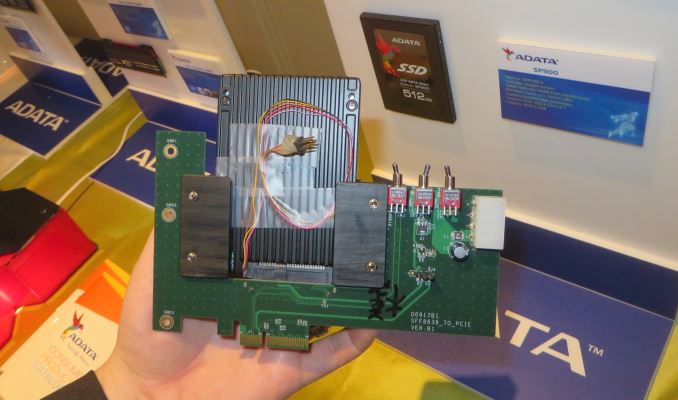CES 2016 Roundup: Total Editor Recall
by AnandTech Staff on January 26, 2016 11:00 AM EST- Posted in
- Trade Shows
- CES 2016
SSD Editor, Billy Tallis
With only a few months as an AnandTech Editor under my belt, this was my first CES and my first time in Las Vegas. The scale of the event is almost incomprehensible (I frequently relied on my smartphone's GPS to navigate even when indoors), and my schedule was packed with meeting after meeting and ten different companies in one day can get hectic. But it was worth it to meet all the company contacts I'd only been introduced to by email, meet most of my fellow AT writers, and get hands on with upcoming SSD technology.
While I would have loved to take the time to look at all the drones flying around (in cages, fortunately) or wait in line to try some of the VR demos, I only had about two hours to explore the CES show floor. That wasn't even enough time to walk past half of the exhibits. I stopped at a few booths to drool over FLIR's thermal cameras while imagining how a PCIe M.2 SSD might light up under their gaze, to gawk at wireless routers competing to have the most antennas, and to look for cameras worth upgrading to, but what I have to report on is just about SSDs.
For months, the SSD market has largely been in a holding pattern awaiting next generation components to make into products that are actually exciting. The high-end SATA market hasn't budged; the low-end market has seen gradual price decreases from transitions to TLC NAND, cheaper controllers and Toshiba's 15nm flash finally replacing their 19nm flash in volume. The PCIe SSD market still suffers from too few choices, such as expensive drives from Intel and Samsung, and a handful of outdated drives that don't support PCIe 3.0 or NVMe and aren't any cheaper for it. The doldrums will be over soon, as 3D NAND and NVMe are about to become widely available from every brand.
We've covered the announcements and roadmap updates from the SSD controller vendors, but haven't highlighted many of the retail products that will be incorporating them. Some of the products demoed were fairly unsurprising, such as Plextor's M7V value SATA drive and successor to the M6V (switching from MLC with the SM2246EN controller to TLC with a Marvell controller); they get to cut costs and have some more room to differentiate their product using in-house custom firmware. The OCZ Trion 150 improves on the Trion 100 by moving from Toshiba's A19nm TLC to their 15nm TLC, with no changes in performance specifications. Aside from cosmetic differences that aren't necessarily finalized, most of the new Phison-based products don't stand out from the crowd and there's nothing much to say about them individually.
The most unusual drive was clearly Mushkin's prototype for a 4TB model in their Reactor line. In order to hit that capacity they're putting two SM2246EN controllers behind a JMicron JMS562. The latter chip is one you'd more commonly expect to find in a multi-bay USB hard drive enclosure, but it can use one of its three SATA channels as the host interface instead of USB, making it into a transparent RAID controller. This reportedly kills random access performance, but Mushkin is expecting to be able to ship the 4TB model for a mere $500, which will greatly help it find a niche.
Plextor's M8Pe NVMe drive using Marvell's 88SS1093 controller will be available as an add-in card or in M.2 2280 form factor. They had a mock-up of a wraparound heatspreader for the M.2 model with a similar motif to the add-in card's heatsink. This is the first M.2 drive we've seen with any sort of heatsink or heatspreader on it, which may become more important as performance increases.
ADATA's exhibit impressed me with the sheer breadth of their product line. Between their consumer, enterprise and industrial SSDs they were showing off drives based on virtually every controller except Phison's. Their IM2P3738N industrial M.2 drive is using Marvell's low-cost 88NV1140 PCIe 3.0 x1 NVMe controller, the first deliberately low-end NVMe product. ADATA crammed all the other new stuff into one demo system: a 2.5" drive with IMFT 3D NAND, an M.2 prototype with Silicon Motion's SM2260 NVMe controller, and a U.2 drive with Marvell's 88SS1093 NVMe controller. The latter drive was in a PCIe to 2.5" U.2 riser card that looked like it would be a handy addition to my testbed. We've asked for a couple in order to do power testing!














44 Comments
View All Comments
Ian Cutress - Tuesday, January 26, 2016 - link
We got clarification from Mushkin. Initially they will be aiming for $0.25/GB, which makes the aim south of $1000. Going down another half is a long-term goal down the line, but it won't happen overnight. I've made an addition clarifying this.hojnikb - Wednesday, January 27, 2016 - link
Its gonna take some time for nand to come down to 0.12c/GB.This probably means 3D TLC nand. I doubt 2d nand can get that cheap for ssd use.
By the time nand will be cheap enough fro 500$/4tb, im sure someone will come up with a controller capable of adressing 4TB of flash (so no need for dual controllers+ raid).
nathanddrews - Wednesday, January 27, 2016 - link
In the words of Darth Vader, "NOOOoooooOOOOooOOOOO!"It was too good to be true. :-(
Dirk_Funk - Tuesday, January 26, 2016 - link
Totally irrelevant but is that an Xbone hdmi cord coming out of the MSI tower on the first page?nathanddrews - Tuesday, January 26, 2016 - link
"This reportedly kills random access performance, but Mushkin is expecting to be able to ship the 4TB model for a mere $500, which will greatly help it find a niche."4TB of NAND for $500. Just let that sink in a bit... So basically, they're slapping two decent 2TB SSDs behind a slower controller. Here's a similar device with the same JMicron controller:
http://amzn.com/B00ITJ7WDC
What sort of random IO "killing" is happening here? To what extent? I would expect a modern SSD with low random IO to still outperform a HDD by a significant margin, but some rough numbers to put it in perspective would help. This could be awesome for a speedy micro-NAS.
Ian Cutress - Tuesday, January 26, 2016 - link
If I recall correctly, we were told '10K IOPS'. Not sure if that's read or write, or if that was the 2TB version or the 4TB version. Billy might know, he was more awake for that meeting :)Billy Tallis - Tuesday, January 26, 2016 - link
10K IOPS sounds right, but I don't have any more context for that number.Since SM2246EN drives have steady-state random write IOPS of around 5k, that metric might actually not be hurt at all by the RAID overhead. But all the other random access numbers would be.
nathanddrews - Tuesday, January 26, 2016 - link
So what you're telling me is that apart from $$/GB, one of these would make for a significant improvement in IOPS over a HDD-based file server. Say no more. ;-)jasonelmore - Tuesday, January 26, 2016 - link
I don't agree with the consensus that VIVE is better than oculus. They are different systems for different use case scenarios.The Oculus Rift is much better at long gaming sessions at your desk, like playing star citizen, euro truck, all flight sims, etc... Due to its light weight and polished design. It can still track in a small playspace, but the controllers require a additional sensor. The Oculus controllers are amazing and groundbreaking IMO. It's to bad they weren't ready to ship with the CV1.
The Vive is meant to be a system for a large play area, like the Nintendo Wii. It's much heavier, and it needs a large area to do most of interactive stuff. The controllers are not as good as oculus's (general consensus of most testers), however the lighthouse's trackers are amazing and they really do push the envelope.
Most of the demo's i've seen in larger playspaces, show the users constantly doing cable management with their feet. Your mind is thinking about the cables subconsciously thus reducing immersion.
Both have similar display specs and performance specs. (1080p @ 90FPS X 2) but Oculus seems to have more exclusives. Good guy steam will support both headsets, but Oculus will have their own exclusive titles. Maybe HTC can sign some exclusive deals, but i just don't see steam requiring you to buy their HMD to play HL3.
HTC, Steam and Oculus, need to focus on getting rid of the cables. (Maybe a Li-Fi System would have the necessary bandwidth) Wireless freedom is much more important for HTC/Steam because of the larger playspaces. I would hold off on the VIVE version 1, and see if version 2.0 is any better. Oculus will be supported by SteamVR, so Steam's involvement shouldn't make you prefer it over the Oculus.
Finally, The VIVE has not been priced yet, and HTC is not a company that can afford to subsidize the hardware. Steam maybe, but not HTC. But we shall see. I'm afraid the VIVE is gonna cost $999 and up for the HMD, 2X controllers and 2X light house sensors.
Nintendo Maniac 64 - Tuesday, January 26, 2016 - link
Is Brandon Chester not aware that LG unveiled a new OLED TV line-up for 2016 that adds support for Dolby-Vision? That by definition is an advancement.